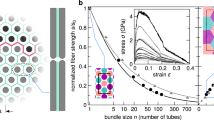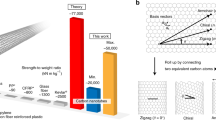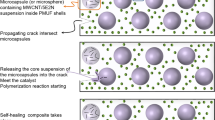Abstract
Carbon nanotubes (CNTs) are under intense investigation in materials science owing to their potential for modifying the electrical conductivity σ, shear viscosity η, and other transport properties of polymeric materials. These particles are hybrids of filler and nanoscale additives because their lengths are macroscopic whereas their cross-sectional dimensions are closer to molecular scales. The combination of extended shape, rigidity and deformability allows CNTs to be mechanically dispersed in polymer matrices in the form of disordered 'jammed' network structures. Our measurements on representative network-forming multiwall nanotube (MWNT) dispersions in polypropylene indicate that these materials exhibit extraordinary flow-induced property changes. Specifically, σ and η both decrease strongly with increasing shear rate, and these nanocomposites exhibit impressively large and negative normal stress differences, a rarely reported phenomenon in soft condensed matter. We illustrate the practical implications of these nonlinear transport properties by showing that MWNTs eliminate die swell in our nanocomposites, an effect crucial for their processing.
This is a preview of subscription content, access via your institution
Access options
Subscribe to this journal
Receive 12 print issues and online access
$259.00 per year
only $21.58 per issue
Buy this article
- Purchase on Springer Link
- Instant access to full article PDF
Prices may be subject to local taxes which are calculated during checkout




Similar content being viewed by others
References
Onsager, L. The effect of shape on the interaction of colloidal particles. Ann. NY Acad. Sci. 51, 627–659 (1949).
Larson, R.G. Arrested tumbling in shearing flows of liquid-crystal polymers. Macromolecules 23, 3983–3992 (1990).
Ren, J.X. & Krishnamoorti, R. Nonlinear viscoelastic properties of layered-silicate-based intercalated nanocomposites. Macromolecules 36, 4443–4451 (2003).
Huxtable, S.T. et al. Interfacial heat flow in carbon nanotube suspensions. Nature Mater. 2, 731–734 (2003).
Baughman, R.H., Zakhidov, A.A. & de Heer, W.A. Carbon nanotubes - the route toward applications. Science 297, 787–792 (2002).
Potschke, P., Fornes, T.D. & Paul, D.R. Rheological behavior of multiwalled carbon nanotube/polycarbonate composites. Polymer 43, 3247–3255 (2002).
Terrones, M. Science and technology of the twenty-first century: Synthesis, properties and applications of carbon nanotubes. Ann. Rev. Mater. Res. 33, 419–501 (2003).
Kashiwagi, T. et al. Thermal degradation and flammability properties of poly(propylene)/carbon nanotube composites. Macromol. Rapid Commun. 23, 761–765 (2002).
Yakobson, B.I., Brabec, C.J. & Bernholc, J. Nanomechanics of carbon tubes: Instabilities beyond linear response. Phys. Rev. Lett. 76, 2511–2514 (1996).
Bicerano, J., Douglas, J.F. & Brune, D.A. Model for the viscosity of particle dispersions. J. Macromol. Sci. Rev. Macromol. Chem. Phys. C39, 561–642 (1999).
Liu, A.J. & Nagel, S.R. Nonlinear dynamics: Jamming is not just cool any more. Nature 396, 21–22 (1998).
Cloitre, M., Borrega, R., Monti, F. & Leibler, L. Glassy dynamics and flow properties of soft colloidal pastes. Phys. Rev. Lett. 90, 068303 (2003).
Garboczi, E.J., Snyder, K.A., Douglas, J.F. & Thorpe, M.F. Geometrical percolation-threshold of overlapping ellipsoids. Phys. Rev. E 52, 819–828 (1995).
Head, D.A., Levine, A.J. & MacKintosh, F.C. Distinct regimes of elastic response and deformation modes of cross-linked cytoskeletal and semiflexible polymer networks. Phys. Rev. E 68, 061907 (2003).
Bin, Y.Z., Kitanaka, M., Zhu, D. & Matsuo, M. Development of highly oriented polyethylene filled with aligned carbon nanotubes by gelation/crystallization from solutions. Macromolecules 36, 6213–6219 (2003).
Kinloch, I.A., Roberts, S.A. & Windle, A.H. A rheological study of concentrated aqueous nanotube dispersions. Polymer 43, 7483–7491 (2002).
MacKintosh, F.C., Kas, J. & Janmey, P.A. Elasticity of semiflexible biopolymer networks. Phys. Rev. Lett. 75, 4425–4428 (1995).
Doi, M. & Edwards, S.F. The Theory of Polymer Dynamics (Oxford Univ. Press, New York 1986).
Safadi, B., Andrews, R. & Grulke, E.A. Multiwalled carbon nanotube polymer composites: Synthesis and characterization of thin films. J. Appl. Polym. Sci. 84, 2660–2669 (2002).
Powell, R.L. Rheology of suspensions of rodlike particles. J. Stat. Phys. 62, 1073–1094 (1991).
Tanner, R.I. Engineering Rheology (Oxford Univ. Press, New York 2000).
Douglas, J.F. “Shift” in polymer blend phase-separation temperature in shear flow. Macromolecules 25, 1468–1474 (1992).
Shaffer, M.S.P. & Windle, A.H. Analogies between polymer solutions and carbon nanotube dispersions. Macromolecules 32, 6864–6866 (1999).
Du, F.M., Fischer, J.E. & Winey, K.I. Coagulation method for preparing single-walled carbon nanotube/poly(methyl methacrylate) composites and their modulus, electrical conductivity, and thermal stability. J. Polym. Sci. Polym. Phys. 41, 3333–3338 (2003).
Martin, J.E. & Heaney, M.B. Reversible thermal fusing model of carbon black current-limiting thermistors. Phys. Rev. B 62, 9390–9397 (2000).
Bossis, G., Meunier, A. & Brady, J.F. Hydrodynamic stress on fractal aggregates of spheres. J. Chem. Phys. 94, 5064–5070 (1991).
Baek, S.G., Magda, J.J. & Larson, R.G. Rheological differences among liquid-crystalline polymers. 1. the 1st and 2nd normal stress differences of Pbg solutions. J. Rheol. 37, 1201–1224 (1993).
Montesi, A., Peña, A.A. & Pasquali, M. Vorticity alignment and negative normal stresses in sheared attractive emulsions. Phys. Rev. Lett. 92, 058303 (2004).
Zarraga, I.E., Hill, D.A. & Leighton, D.T. The characterization of the total stress of concentrated suspensions of noncolloidal spheres in Newtonian fluids. J. Rheol. 44, 185–220 (2000).
Kolli, V.G., Pollauf, E.J. & Gadala-Maria, F. Transient normal stress response in a concentrated suspension of spherical particles. J. Rheol. 46, 321–334 (2002).
Singh, A. & Nott, P.R. Experimental measurements of the normal stresses in sheared Stokesian suspensions. J. Fluid Mech. 490, 293–320 (2003).
Aral, B.K. & Kalyon, D.M. Viscoelastic material functions of noncolloidal suspensions with spherical particles. J. Rheol. 41, 599–620 (1997).
Moan, M., Aubry, T. & Bossard, F. Nonlinear behavior of very concentrated suspensions of plate-like kaolin particles in shear flow. J. Rheol. 47, 1493–1504 (2003).
Brady, J.F. & Carpen, I.C. Second normal stress jump instability in non-Newtonian fluids. J. Non-Newton. Fluid Mech. 102, 219–232 (2002).
Davis, V.A. et al. Phase behavior and rheology of SWNTs in superacids. Macromolecules 37, 154–160 (2004).
Lin-Gibson, S., Pathak, J.A., Grulke, E.A., Wang, H. & Hobbie, E.K. Elastic-flow instability in nanotube suspensions. Phys. Rev. Lett. 92, 048302 (2004).
Sierou, A. & Brady, J.F. Rheology and microstructure in concentrated noncolloidal suspensions. J. Rheol. 46, 1031–1056 (2002).
Schmid, C.F. & Klingenberg, D.J. Mechanical flocculation in flowing fiber suspensions. Phys. Rev. Lett. 84, 290–293 (2004).
Becker, L.E. & Shelley, M.J. Instability of elastic filaments in shear flow yields first-normal-stress differences. Phys. Rev. Lett. 87, 198301 (2001).
Jerman, R.E. & Baird, D.G. Rheological properties of copolyester liquid-crystalline melts. 1. Capillary rheometry. J. Rheol. 25, 275–292 (1981).
Author information
Authors and Affiliations
Corresponding authors
Ethics declarations
Competing interests
The authors declare no competing financial interests.
Rights and permissions
About this article
Cite this article
Kharchenko, S., Douglas, J., Obrzut, J. et al. Flow-induced properties of nanotube-filled polymer materials. Nature Mater 3, 564–568 (2004). https://doi.org/10.1038/nmat1183
Received:
Accepted:
Published:
Issue Date:
DOI: https://doi.org/10.1038/nmat1183
This article is cited by
-
Influence of halloysite nanotubes on mechanical and swelling properties of silicone rubber compound
Journal of Polymer Research (2023)
-
Graphene oxide dispersion state in polystyrene-based composites below percolation threshold via linear melt rheology
Rheologica Acta (2021)
-
Robust Surface-Engineered Tape-Cast and Extrusion Methods to Fabricate Electrically-Conductive Poly(vinylidene fluoride)/Carbon Nanotube Filaments for Corrosion-Resistant 3D Printing Applications
Scientific Reports (2019)
-
A review of the electrical and mechanical properties of carbon nanofiller-reinforced polymer composites
Journal of Materials Science (2019)
-
Self-Healing and Rheological Properties of Polyhydroxyurethane Elastomers Based on Glycerol Carbonate Capped Prepolymers
Macromolecular Research (2019)



